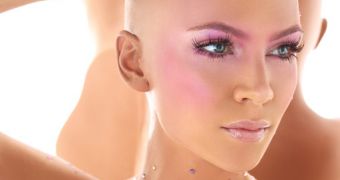Hair loss is more than a physical issue. For many people, it is a great fatality that even changes their character. They turn more introverted, avoid relations with the others, get low self esteem, and even depression. Men will think that the others see them as being less attractive and sometimes even less virile (paradoxically, most men suffer genetic baldness linked to testosterone, the sex hormone, thus balder can show off in some cases higher testosterone levels, linked to higher sex drive and sex function).
If this is unpleasant for a man, you can imagine what it means for a woman. They can even experience a real social rejection (which is not imaginary in this case).
While in men baldness is localized to the crown of the head and hairline, in women this takes place in a diffuse manner: hair gets rarer all over the hair area (alopecia difusa feminina).
If not genetic, a temporary hair loss can be caused by chemicals and diet. Drugs known to have this effect are cholesterol, chemotherapy substances, anticoagulants, some antibiotics and anti-schizophrenia medication. If you follow a hypocaloric (low in calories) diet for losing weight, you may get rid of those extra-pounds, but your hair pays also, increasing failing. The effect is felt 2-3 months after starting the diet.
These are three therapeutic methods against severe hair loss:
1. Topic treatment employs a drug whose active principle is minoxidil, which works in both men and women. In 90 % of the cases it stops the hair loss and the advance of bald areas, and in some persons even the recovery of some lost areas, but the new hair will always be finer than the normal hair.
This treatment is not for hypertensive persons, nor for those suffering of heart or kidney, as minoxidil is a powerful peripheral vasodilator.
2. Oral drugs. They are based on finasteride, a synthetic testosterone inhibitor, which acts on the root of the hair. It is indicated for men aged 18 to 41 with excellent results in 50 % of the cases and very notable in over 33 % of the cases. This drug is definitely not recommended for women.
3. Hair autotransplant. It is the last solution for both men and women. Hair is extracted from the nape of the patient and transplanted, root included, in the bald area. Now, the most employed method is the micrograft, which consists in transplanting the hairs one by one or two by two. This way, a more aesthetic result is achieved, compared to transplanting a larger hair skin graft.

 14 DAY TRIAL //
14 DAY TRIAL //